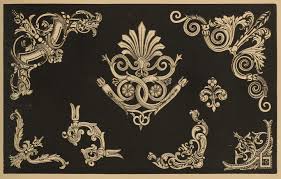 |
| Doom scrolling |
Hints on Household Taste, Charles L. Eastlake
The idiot who praises, with enthusiastic tone,
All centuries but this, and every country but his own.
(W.S. Gilbert)
Books of “hints” on all aspects of life were popular when furniture designer Charles Eastlake published his suggestions for creating a tasteful home, but if you were expecting “how to clean an oriental rug with tealeaves”, you’ll be disappointed.
Eastlake's clear, simple prose makes his diatribes against “sentimental young ladies” and their love of ribbon decoration even more stinging. Hardly anything is good enough for him. Some Bavarian door-knockers he illustrates are “somewhat too late to exhibit quite the right spirit of design”.
He bewails the baroque taste of the 1860s, derived from the era of French kings called Louis. Such tables, chairs, sideboards, beds: “There is not a straight line in their composition... this detestable system of ornamentation is called ‘shaping’.” He despises “scroll” ornament, suggesting that though it may be intended as foliage, it actually looks like a collection of the letter G (see picture). He dislikes imitations: “All articles of plate which represent in miniature objects of a different material – as barrels, tubs and baskets – are to be avoided.” Copies of oriental rugs won’t do because they are too perfect, but “I do not see exactly how veneering is to be rejected on ‘moral’ grounds.”
If people WILL prefer a bouquet of flowers or a group of spaniels worked upon their hearthrug to the conventional patterns which are adopted by the Indian and Turkish weavers, it is difficult to convince them of their error... The quasi-fidelity with which the forms of a rose or a bunch of ribbons, or a ruined castle, can be reproduced on carpets, crockery and wall-papers will always possess a certain kind of charm for the uneducated eye.
Modern wallpapers are “wretched specimens... gaudy and extravagant trash”. He recommends taupe, pale green, silver-grey and cream.
It is a great pity that ladies who devote much of their time to the execution of the wretched [edging] patterns sold at ‘fancy-work shops’ do not exercise a little more discrimination in their choice... The so-called ‘ornamental’ leatherwork which a few years ago was so in vogue with young ladies... is utterly opposed to sound principles of taste.
He condemns light furniture (easy to rearrange as desired) as flimsy and feminine, and recommends high-backed settles to keep off draughts. “The drawing-room may be crowded with silly knick-knacks,” but libraries are to be a mancave. However, instead of a Grecian funerary urn, adorn the top of your bookcase with a miniature copy of a good Greek sculpture – the Gladiator, the Discobolos, Antinous.
When I look into the windows of some establishments devoted to decorative art, and see the monstrosities which are daily offered to the public in the name of taste – the fat gilt cupids, the coarse and clumsy mouldings, the heavy plaster cornices, and the lifeless types of leaves and flowers which pass for ornament in the nineteenth century – I cannot help thinking how much we might learn from those nations whose art it has long been our custom to despise – from the half-civilised craftsmen of Japan, and the rude barbarians of Feejee. (He got his wish – in the later 19th century there was a craze for all things Japanese.)
So, Eastlake, where are the positives? He shamelessly promotes his own furniture – blocky and heavy, lots of oak and strap hinges – and recommends an approach still followed by England’s upper-middle classes. Why not use an “honest” wooden bucket as a coal scuttle, instead of a cast-iron monstrosity with a view of Edinburgh Castle let into the lid? For knick-knacks, look either to the past (the Renaissance) or to current designers who copy good earlier models: Minton and de Morgan. He praises a type of curtain fabric whose stripes recycled actual horse-girths.
His ideas live on among the Upwards, who go for anything rustic (made by peasants from far, far away), or functional (French enamel coffee pots), or genuinely old (the kitsch of Eastlake’s day is now antique). What would Eastlake think of today’s “country” interior with artificially distressed (new) wood everywhere?
His ideas were taken up by the less cultured, and by the 1920s the Tudorbethan style was all over the suburbs, complete with heavy sideboards, Welsh dressers and appliquéd oak beams. The fashion was guyed at the Festival of Britain as “Gremlin Grange”, a warped cottage with twisted timbers and diamond-paned windows. What NOT to build, explained the designers, who were rehousing blitz victims in gleaming modernist estates and towers.
More here, and links to the rest.

No comments:
Post a Comment